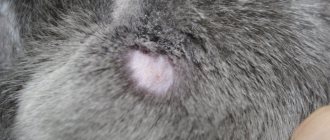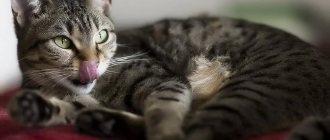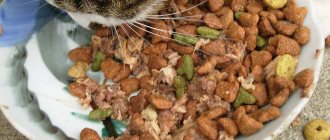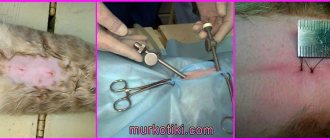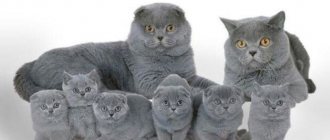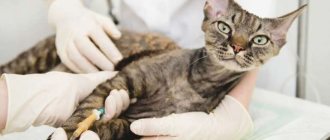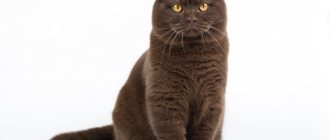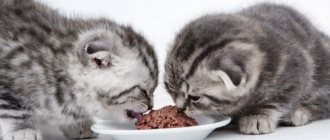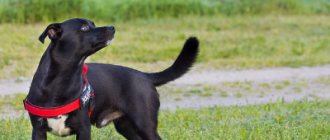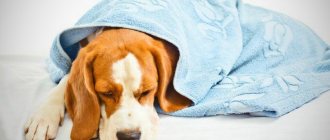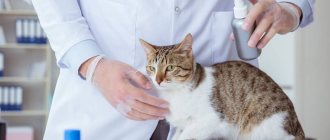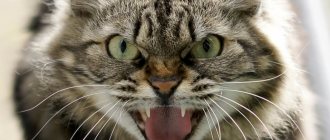Features of the appearance of the Scottish Fold cat breed are short thick “plush” fur, a rounded shape of the head and eyes, as well as small, downward “envelope” ears. Such characteristics of the breed were selectively fixed from a spontaneously developed mutation of a semi-wild cat living in Scotland, where, in fact, the name of the breed came from. Scottish Folds are very friendly and have a soft, affectionate character. Unfortunately, they are much more prone to a disease affecting the skeletal system than other breeds, which is called osteochondrodysplasia (OCD).
What is OHD
Translated from Greek, “osteo” means bone, and “dysplasia” means a developmental disorder.
OCD is a genetic malformation of cartilage and bone tissue, leading to a slowdown in their growth. The result of this pathology is underdevelopment of the osteochondral system, including the ear cartilage (which is why cats of this breed have “falling” ears). Systemic skeletal lesions are most often expressed by deformation of the limbs. This disease often does not pose a direct threat to the animal’s life, but can significantly reduce its quality and duration. Important! The purebred Scottish Fold and Highland Fold breeds are at risk for this disease. Both of them have a “defective” gene in their pedigree
If one of the cat’s parents was a Scottish Straight (Scottish Straight or Highland Straight), he will inherit one mutated gene, and the animal’s chances of developing osteochondrodysplasia will be halved.
Do straight-eared Scottish cats suffer from this?
The straight-eared Scottish Straight and Highland Straight varieties of Scottish cats are no more susceptible to osteochondrodysplasia than any other breeds (this disease does not only affect Scots, it’s just more common in Folds). Straits do not have deformed cartilages and do not have the gene for lop ears, and it is this gene that makes cats vulnerable to osteochondrodysplasia. By the way, not only the Scots are considered vulnerable for this trait, but also the Ukrainian Levkoy, in the selection of which Scottish Fold cats were used.
Symptoms
The first thing you need to pay attention to is the general condition and mood of the cat. An unhealthy Scottish Fold will be lethargic, apathetic, lack of appetite, sometimes irritable reactions and unreasonable aggression
The nose becomes dry and very hot to the touch. Perspiration may appear on the fur. When measuring temperature, the readings will exceed 38.5 °C.
In specific diseases, the cat owner can focus on the symptoms.
Table 2. Symptoms of diseases of internal organs
| Type of disease | First symptoms |
| Viruses | Sneezing, discharge from mouth and nose, fever |
| Ear | The cat shakes its head, discharge from the ears (pus, fluid), putrid smell from the shells, redness of the skin in the shells, the cat scratches its ears |
| Ophthalmic | Redness, lacrimation, purulent discharge, swelling of the eyelids of varying degrees, the cat tries to scratch the eyes, poor orientation in space, cloudy pupils |
| Digestive | Refusal to eat, vomiting, nausea, constipation, diarrhea, undigested pieces in feces, increased thirst |
| Skin | Scabies, redness, bald patches, rashes, sores, blisters, peeling, nodules |
| Heartfelt | Shortness of breath, cough, swelling, increased frequency of sighs, low temperature, fainting |
| Genitourinary system | Sudden weight loss, pink urine, apathy, frequent urination, the cat meows when urinating, fussing |
| Bone | Disproportionately large head, crooked, protruding jaw, shortened limbs, curvature of the spine, twisted front legs, joints with a swollen effect, too massive joints, growths on them, slow or absent growth of the cat, shortened thick tail, inactivity, clumsiness of movements, attempts not to bend the paws when moving |
| Dental | Foam, pus, excessive drool from the mouth, bad odor from the mouth, yellow, brown, gray growths on the teeth, brittle teeth, refusal to eat (it hurts to eat) |
In the early stages, 2-3 mild symptoms may be observed. As the pathology develops, the number of manifestations increases. It is necessary to monitor your fold ear and consult a doctor at the first suspicion of abnormalities.
Links
1. Niewald M, Seegenschmiedt MH, Micke O, et al. Randomized multicenter trial on the e?ect of radiotherapy for plantar
Fasciitis (painful heel spur) using very low doses–a study protocol. Radiat Oncol 2008;3:27.
2. Rodel F, Frey B, Manda K, et al. Immunomodulatory properties and molecular e?ects in in?amatory diseases of low-dose x-irradiation. Front Oncol 2012;2:120.
3. Hautmann MG, Neumaier U, Kolbl O. Re-irradiation for painful heel spur syndrome. Retrospective analysis of 101 heels. StrahlentherOnkol2014;190:298–303.
4. Koca T, Aydin A, Sezen D, et al. Painful plantar heel spur treatment with Co-60 teletherapy: factors in?uencing treatment outcome. Springerplus2014;3:21.
5. Arenas M, Sabater S, Hernandez V, et al. Anti-in?amatory e?ects of low-dose radiotherapy. Indications, dose, and radiobiological mechanisms involved. StrahlentherOnkol2012;188:975–981.
6. HublerM, Volkert M, Kaser-Hotz B, et al. Palliative irradiation of Scottish Fold osteochondrodysplasia. Vet Radiol Ultrasound 2004;45:582–585.
7. Wastlhuber J, Pederson NC. Diseases and Management in the Multiple-cat Environment. In: Pederson NC, ed. Feline Husbandry. California: Goleta; 1991:12–14.
8. Robinson R.Normal Genetics, Genetic Disorders, Developmental Anomalies and Breeding Programs. In: Pederson NC, ed.Feline Husbandry. California: Goleta; 1991:75–76.
9. Malik R. Genetic diseases of cats. J Feline Med Surg 2001;3:109–113.
10. Takanosu M, Takanosu T, Suzuki H, et al. Incomplete dominant osteochondrodysplasia in heterozygous Scottish Fold cats. J Small AnimPract2008;49:197–199.
11. Chang J, Jung J, Oh S, et al. Osteochondrodysplasia in three Scottish Fold cats. J Vet Sci 2007;8:307–309.
12. Malik R, Allan GS, Howlett CR, et al. Osteochondrodys- plasia in Scottish Fold cats. Aust Vet J 1999;77:85–92.
13. Mathews KG, Koblik PD, Knoeckel MJ, et al. Resolution of lameness associated with Scottish fold osteodystrophy following bilateral ostectomies and pantarsalarthrodeses: a case report. J Am Anim Hosp Assoc1995;31:280–288.
14. Kataoka T. Study of antioxidative e?ects and anti-in?amatory e?ects in mice due to low-dose X-irradiation or radon inhalation. J Radiat Res 2013;54:587–596.
15. Frey B, Hehlgans S, Rodel F, et al. Modulation of in?amation by low and high doses of ionizing radiation: implications for benign and malign diseases. Cancer Lett. Forthcoming 2015.
16. Emami B, Lyman J, Brown A, et al. Tolerance of normal tissue to therapeutic irradiation. Int J Radiat Oncol Biol Phys 1991;21:109–122.
17. Bomford CK, Kunkler IH, Hancock BW. Principles of Management and Dosage. Walter and Miller's Textbook of Radiotherapy, 6th edn. London: Churchill Livingstone; 2003: 307–323.
18. University of California. Davis: The Association; c2013–2015. Veterinary Genetics Laboratory; . Available at: https://www.vgl.ucdavis.edu/services/ScottishFold.php.
19. Gandol? B, Lyons LA, Adhikari B, et al. Inherited osteoarthropathy in Scottish Fold cats is associated with altered calcium channel function. In: Bailey E, Ciobanu D, Kim KS, eds. Plant{amp}amp; Animal Genome: Proceeding of the 13th international conference on the status of plant {amp}amp; animal genome research. SanDiego, CA; 2015: 151.
20. Tsang AK, Taverne A, Holcombe T. Marfan syndrome: a review of the literature and case report. Spec Care Dentist 2013;33:248–254.
21. Tuncbilek E, Alanay Y. Congenital contractural arachnodactyly (Beals syndrome). Orphanet J Rare Dis 2006;1:20.
Treatment
Unfortunately, it is not possible to completely cure a cat with OCD; you can only support the body and to some extent improve the animal’s quality of life, for this:
The diet is adjusted, it should include everything necessary. Particular attention is paid to vitamins and minerals; if they are deficient or excessive, the disease can progress faster. In case of exacerbation, when the animal experiences severe pain, non-steroidal anti-inflammatory drugs are used, but with caution. Here are the side effects of NSAIDs. Before using them, you need to check the condition of your kidneys, otherwise they can cause harm. Sometimes surgical treatment methods are used, but this is also not a panacea, but only a way to alleviate the condition.
Treatment
The success of treatment for feline OCD depends on the degree of damage to the skeletal system. The earlier the disease is detected, the greater the chance of a good prognosis. Already developed skeletal changes persist until the end of life, but adequate therapy can slow down or even stop their further development.
In any case, treatment measures are primarily aimed at eliminating the main symptoms of osteochondrodysplasia: relieving pain, inflammation and joint stiffness. If your pet does not suffer from kidney disease, he may be prescribed non-steroidal anti-inflammatory drugs: Meloxivet, Ketoline, Ainil.
To stimulate the proper development of cartilage tissue, Pentosan can be prescribed, which has a chondroprotective and anti-inflammatory effect, as well as glycosaminoglycans involved in the construction of the cartilage matrix:
- Chondroitin-4-sulfate;
- Chondroitin-6-sulfate;
- Furinaid;
- Interpan.
These drugs slow down the processes of degeneration of bone and cartilage tissue and maintain the amount of synovial fluid in the joint capsule at the proper level.
Manual therapy or massage can alleviate the animal’s condition, but these physical procedures must be performed by a professional specialist. In severe cases of osteochondrodysplasia, your pet may need surgery to remove bone growths called exostoses that have formed on the joints. After such an operation, the cat’s lameness usually decreases and pain is partially or completely relieved. In some countries, radiation therapy is used to treat OCD.
Important! To improve the quality of life of a cat suffering from osteochondrodysplasia and increase its life expectancy, in addition to drug therapy, it is necessary to organize a balanced diet and prevent the development of obesity, since excess weight is an extra load on the skeletal system weakened by the disease.
If your cat has signs of osteochondrodysplasia, his diet should be special. The diet must include specialized supplements that help strengthen bone and cartilage tissue: calcium, phosphorus, iron, iodine, B vitamins. This will prevent the possibility of fractures and slow down degenerative processes.
Veterinarians consider the best food option for cats with OCD to be natural, home-cooked food. If ready-made feeds are used, then you should choose specialized complexes intended for animals with diseases of the musculoskeletal system. Such complexes contain all the necessary vitamins, macro- and microelements.
Osteochondrodysplasia in a Scottish fold cat is not a death sentence. With timely detected pathology, proper treatment and competent, caring care, your pet can feel good and live a long life.
The Scottish Fold owes its characteristic curled (or drooping) ears to a semi-wild cat from Scotland with a spontaneously occurring mutation. Curled ears were specially secured by selection. In 1966, this new breed was registered in England. But then it turned out that along with unusual ears, cats also inherit pathology of cartilage tissue. The breed was canceled in 1974 (and the breed is currently not registered in England).
However, the Scottish Fold breed is recognized in North America by the Cat Fanciers Association. Offspring can only be obtained from crossing Scottish straight-eared and fold-eared cats (when crossing two fold-eared cats, the offspring is obtained with gross defects). Curled ears in cats are a manifestation of a cartilage defect.
Osteochondrodystrophy is a hereditary disease in which deformation of not only the ears, but also the skeleton (short, curved limbs, thickened tail) develops. Cats with osteochondrodystrophy cannot jump, they do not like active games, their gait is “stilted” or limping. The disease is not immediately noticeable. Cats try to transfer the load to a healthy limb, and since cats are light in weight, they succeed for quite a long time, until arthritis develops. Due to underdevelopment or deformation of the limbs, cats look squat or “crouched”. Lameness appears early (from the first months). This disease is diagnosed using radiography.
There is no specific treatment. But to relieve pain, relieve swelling, increase joint fluid to “lubricate” the joint, and restore cartilage tissue, nonsteroidal anti-inflammatory drugs (meloxicam 0.1 mg/kg) and chondroprotectors (glucosamine and chondroitin) are used. In severe cases, surgical correction or radiation therapy is indicated.
How long do sick cats live?
It is unlikely that anyone will give you a specific prognosis for the life expectancy of cats with osteochondrodysplasia. Unless such responsibility will be assumed by the treating veterinarian who has fully examined the animal. And even then the forecasts are often wrong. Also, veterinarians often mistakenly suggest euthanizing a seriously ill animal or cutting off a limb, although, in fact, with the correct selection of medications and proper care, as well as the patience and love of the owner, the cat’s condition can be seriously improved. Therefore, do not be upset immediately as soon as you hear from the doctor that the cat has no future. Be sure to consult with 1-2 more veterinarians. Only then make a decision!
The first signs of osteochondrodysplasia in Scottish fold cats can appear as early as a couple of months, so when choosing a kitten it is so important to pay attention to the behavior of the cat, the curvature of the paws, the presence of kinks in the tail, its mobility and length. It all starts with minor changes that may not be noticed if you don’t set such a goal. In most cats, the disease becomes noticeable later, when they have already found permanent homes.
The rate at which the disease progresses and its severity varies among individuals. The time of visible manifestation of the disease is the same. However, veterinarians recommend that all owners of fold-eared cats closely monitor the condition of the pet and, at the first signs, run to the veterinary clinic, because further quality of life will directly depend on how early treatment is started.
To increase the life expectancy of a sick cat, it is necessary, in addition to drug therapy, to balance the diet and prevent the appearance of excess weight, because it creates additional stress on the musculoskeletal system.
Pets with especially severe manifestations of the disease once again try not to move. Sometimes it is even difficult for such cats to reach the litter box, and therefore they may relieve themselves in the wrong place or on their own. If this has become a system, you can purchase special cat diapers. Then the cat will urinate and poop in them, thereby saving you from unnecessary problems.
If your cat is diagnosed with such a disease, we would like to advise you not to despair. For inspiration, watch a video about a rescued cat with osteochondrodysplasia, which, due to illness, was kicked out of the house by its owners in 40-degree frost, but a few days later it was rescued by volunteers, they came out - and now she lives happily in a new family.
However, in some cases it is still recommended to euthanize the cat. These are cases of severe progressive disease with pain. If the animal is suffering, cannot lead a normal life, is constantly on pills that do not help much, veterinarians advise stopping the cat’s suffering. And in this case they are most likely right. However, the final decision is up to the owner.
Symptoms of osteochondrodysplasia
Osteochondrodysplasia is a hereditary disease. At the initial stage, the disease is practically asymptomatic, and over time the following signs of osteochondrodysplasia appear:
- pronounced deformation of the hind limbs;
- lameness;
- unsteady gait.
Lameness has the ability to disappear and recur, and the cat does not necessarily limp on the same paw. Over time, the cat spends more and more time on the ground, since it is no longer able to jump onto a hill. In some cases, arthritis develops in a pet due to osteochondrodysplasia. The cat experiences pain in the limbs and begins to behave restlessly. In advanced cases, owners notice a significant change in the pet’s gait, as it becomes tighter. Such changes occur due to damage to the cat's transverse skeleton.
If one or more characteristic signs of osteochondrodysplasia are detected, your pet should be immediately taken to an appointment with a veterinarian. The sooner drug treatment is started, the greater the likelihood of a successful outcome. In the first months after the birth of a kitten, owners need to closely monitor the condition of its limbs and, at the slightest change in them, take their pet to a veterinary clinic for an x-ray.
Chocolate Briton - photo, description and character
Diagnostics
A veterinarian will help diagnose osteochondrodystrophy in a Scottish breed cat, who, after an initial examination and history taking, will give a referral for an X-ray examination. If this disease progresses in Scots, changes in the tarsus, wrist, and vertebrae will be clearly visible on the pictures. To exclude or confirm other causes that may affect the formation and development of the osteochondral system, a clinical blood and urine test, as well as biochemistry, are additionally prescribed. To confirm the diagnosis, a bone tissue sample is taken.
Treatment
The changes that occur in the bones and joints are irreversible, the disease is incurable. Many veterinarians may advise euthanasia of sick kittens with the mandatory exclusion of their parents from breeding. But if the owners have already become attached to the new family member, they cannot decide to take such a step. Then supportive – palliative – treatment is prescribed.
A variety of chondroprotectors are widely used - preparations based on glucosamine and chondroitin. But their effectiveness has not been proven and is equivalent to placebo. Because sick kittens experience constant and severe pain, your doctor may recommend nonsteroidal anti-inflammatory drugs. Meloxicam-based medications are the safest for cats. Unfortunately, their long-term use threatens the development of side effects.
If the owners are determined to fight for the life of their pet to the last, they are offered surgical treatment. It consists of removing exostoses (osteotomy) and forming arthrodesis of the heel joints. In other words, the joint is fixed in the optimal position by a metal structure and remains motionless forever. Sometimes this can reduce the pain your cat experiences when walking.
Successful experiments are being conducted to administer radiation therapy to sick cats. Radiation can reduce joint inflammation and stop further bone growth for several months or even years. Unfortunately, in Russia there are almost no veterinary clinics where radiation therapy is available to animals. This is due not only to the high cost of equipment, but also to the need to obtain a license and train personnel.
As a long-term recommendation, doctors advise never to overfeed your pet. Cats that are sedentary due to illness quickly gain weight if they are not fed properly, which increases the load on their joints. Typically, sick kittens are prescribed high-grade industrial food so that osteochondrodysplasia is not aggravated by secondary hyperparathyroidism.
Case 2
A 2-year-old neutered male Scottish Fold was referred to the Veterinary University Hospital of the Japan Veterinary and Life Sciences University due to chronic pain in the pelvic limbs for 3 months. Clinical manifestations were relieved by the administration of meloxicam, but recurred after discontinuation of the drug. The animal resisted palpation of the pelvic limbs. Despite the obvious shortening of the limbs, their deformation was not noted.
X-rays of all four limbs, tail, abdominal organs and chest were performed. In the area of the calcaneus of the left pelvic limb, there was fresh growth of bone tissue, and the presence of osteophytes of the tarsal joints on both sides was noted. No other lesions of the bones of the thoracic limbs or tail were detected during radiography.
The animal was diagnosed with Scottish Fold osteochondrodysplasia and followed up for 59 months. In order to relieve the manifestations of chronic pain syndrome, irradiation of the pelvic limbs was carried out according to the protocol described above. Clinical manifestations resolved after 1 month from the start of radiation therapy. No acute adverse effects were observed in the irradiated areas. At the end of the course of radiation therapy, radiography was performed regularly. At the 4th month, the appearance of plantar exostosis was noted. There was progression of exostosis up to 26 months, but by 59 months no further progression was noted. There was continued growth of osteophytes of the right tarsal joint up to 50 months, but no further progression was noted by 59 months. No late complications were identified during this period. The animal's condition was stable and meloxicam was not required.
Rice. 1. Radiographs of the limbs and tail of the animal from Case 1. 1-1 Radiographs at the time of diagnosis (0 months). (A) Right wrist joint (lateral view).
(B) Left wrist joint (lateral view). (C) Both carpal joints (dorsoventral view). (D) Both tarsal joints (dorsoventral view). (E) Right tarsal joint (lateral view). (F) Left tarsal joint (lateral view). (G) Tail (ventro-dorsal view). (H) Tail (lateral view). 1–2 Series of radiographs of the thoracic extremities at 12, 24, 36, and 60 months. Radiographic findings did not change over time. 1–3 Series of radiographs of the pelvic limbs at 12, 24, 36, and 60 months. Radiographic findings did not change over time.
Rice. 2. Case 1 animal 60 months after radiation therapy. Although the limbs and tail showed obvious shortening, thickening and deformation, these lesions were indistinguishable from the lesions at the time of diagnosis. (A) Muzzle and floppy ears. (B) Tail. (C) Thoracic limbs. (D) Phalanges and paw pads of the thoracic limbs. (E) Right pelvic limb. (F) Phalanges and paw pads of the pelvic limbs.
Treatment
There is no treatment that can eliminate the disease once and for all. Cats with this problem are prescribed maintenance therapy, which can improve quality of life. However, it does not always improve so much that the pet can at least walk.
In cats showing early signs of the disease, pain can be controlled with nonsteroidal anti-inflammatory drugs. Chondroprotectors are also prescribed, most often glucosamine and chondroitin sulfate. They are believed to help reduce cartilage degeneration and increase the amount of joint fluid. However, there are no studies that would confirm this 100%. However, doctors still prescribe these drugs because... The choice of treatment methods for OCD is, in principle, small.
Manual therapy with massage has also proven itself well, but it must be carried out by a professional.
In severe cases, surgery (osteotomy and arthrodesis) is indicated. The operation can give very good results if there are indications for it.
Radiation therapy in the treatment of OCD
There is also an experimental treatment originally from England, where such cats are irradiated. Similar experiments are being carried out in Japan. Radiation therapy has already been proven effective in certain individuals: it relieves pain and prevents further destruction of the joints. However, the problem is that such treatment is practiced in few places, and our clinics do not have the necessary equipment.
“In medicine, low-dose radiation therapy is usually used to treat inflammatory and degenerative diseases. Although the mechanisms of the analgesic effect have not yet been clarified, they are suggested to be related to the anti-inflammatory effect. Radiation is considered a promising treatment option for osteochondrodysplasia, but long-term evaluation of its effectiveness and late complications has not been adequately assessed. There is insufficient information on the clinical use of this treatment. Further studies with a larger sample size and longer follow-up period are required,” concluded the Japanese doctors who conducted the study.
It is worth noting that radiation therapy is still largely an attempt to relieve pain and slow down the progression of dysplasia for seriously ill animals. However, if it was possible to stop the pain syndrome in all cases, then it was not possible to stop the progression of the disease. There is still a lot of uncertainty in this technique.
Discussion
In humane medicine, low-dose radiation therapy is typically used to treat inflammatory and degenerative diseases, including painful symptoms of heel spurs, tennis elbow/golfer's elbow syndrome, painful symptoms of osteoarthritis and
hyperproliferative diseases.1–4 Although the mechanisms of the analgesic effect have not yet been elucidated in detail, their connection with the anti-inflammatory effect is suggested.1 Despite the fact that veterinary medicine has experience in using an experimental model of treating arthritis in animals using low-dose radiation therapy,5 information about clinical use of such treatment is insufficient. An example of the use of low-dose radiotherapy for the treatment of osteochondrodysplasia in the Scottish Fold is described in one animal of this breed;6 however, further studies with a larger sample size and longer follow-up are required.
The Scottish Fold cat breed was developed in Perthshire, Scotland in the early 1960s. In 1961, a white cat with folded ears was found on a local farm. This individual, which had a natural anomaly, became the ancestor of the Scottish Fold breed. The breed was entered into the British Cat Fancy register in 1966, but in 1974 the breed was banned in England due to cases of deafness and limb deformities (osteochondrodysplasia). Breeding of the breed continued in the United States, where it was registered in 1972.7–9 The Scottish Fold cat's appearance includes characteristic features: forward folded ears, large round eyes, a subtle curve of the nose and short thickened limbs. Due to its cute appearance and friendly disposition,7 the Scottish Fold is one of the popular breeds in Japan.
It is widely known that osteochondrodysplasia is an inherited disease of Scottish Fold cats.8,9 It is inherited as an incomplete autosomal dominant trait. The allele that determines the presence of folded ears is called Fd.10 Homozygous individuals (Fd/Fd) suffer from severe osteochondrosisplasia. In heterozygotes (Fd/fd), the disease has a milder course.10,11 To avoid the birth of homozygotes, it is recommended to cross lop-eared individuals with individuals having a normal ear shape.7,9 Homozygous individuals with normal-shaped ears are called Scottish Shorthairs, and they do not develop diseases.9 The described disease is characterized by deformations of the distal parts of the limbs and deformations of the skeleton of the tail.7 During pathohistological examination, defective development and functional inferiority of cartilage can be identified.12 Clinical manifestations are lameness and impaired tolerance to physical activity, in particular, the animal’s reluctance to jump and run because for chronically persistent pain. Because osteochondrodysplasia prevents a cat from engaging in a lifestyle that requires physical strength and agility, the cat's quality of life is likely to suffer.
This disease is an inherited disorder, and supportive care includes oral medications, surgery, and radiation to palliate chronic pain.6,11–13 Drug treatment, including nonsteroidal anti-inflammatory drugs, glycosaminoglycans, and pentosan polysulfate, has a moderate effect . Because Scottish Fold osteochondrodysplasia develops early in life, long-term use of drugs is not realistic.11,12 One publication reported temporary analgesic relief with osteotomy, but recurrence of lameness occurred after 48 weeks.13Hubler et al. described the use of radiation to both pelvic limbs in one Scottish Fold cat, which resulted in relief of pain, but after 28 months, bone proliferation was again noted.6 Although radiation is considered a promising treatment option for osteochondrodysplasia of the Scottish Fold, long-term efficacy and late complications have not been adequately assessed. The purpose of this publication is to evaluate the long-term effectiveness of radiotherapy in three Scottish Fold cats suffering from osteochondrodysplasia, as well as adverse events.
Forecasts
The lifespan of Scottish cats affected by osteochondrodysplasia is difficult to predict in advance. It largely depends on how willing the owners are to care for a disabled kitten.
For long-term prognosis, it is necessary to exclude other genetic diseases of Scottish cats, which can occur with irresponsible breeding as often as osteochondrodysplasia. These are polycystic kidney disease and hypertrophic cardiomyopathy, which can be detected using ultrasound.
With mild osteochondrodysplasia, cats can live for years, although they require constant supportive treatment and special housing conditions. For example, they may find it painful to go to the toilet, which leads to urination in the wrong places and chronic constipation.
If the sick kitten is homozygous for the lop-eared gene (both parents are Scottish Folds), the prognosis for life is extremely unfavorable. Bone deformation causes severe pain, which becomes increasingly difficult to relieve with age. The animal cannot move, and at some point the owners resort to euthanasia as a means of ending the suffering of their beloved pet.
Causes
It has been proven that osteochondrodysplasia is a hereditary disease. The same gene that causes the auricle to deform and curl causes irreversible changes in other cartilage and bones. For this reason, they wanted to ban the breeding of Scottish fold cats; many veterinarians still advocate for this.
At first it was believed that only those kittens that received the lop-eared gene from both parents were susceptible to osteochondrodysplasia. Fold is inherited in a dominant manner, so it was supposed to solve the problem by crossing Scottish Folds with (Scottish Straight cats). If a cat has straight ears, then it is guaranteed not to carry the osteochondrodysplasia gene.
Unfortunately, further research has shown that even kittens heterozygous for the lop ear gene can develop osteochondrodysplasia, albeit in a milder form. Their osteoarthritis does not appear as early as in kittens obtained from crossing two fold-eared cats.
Vaccination of Scottish Fold cats
Vaccination is one of the first preventive measures for animals. The risk of developing the disease with timely vaccinations decreases significantly. The doctor chooses a set of medications based on the living conditions.
The first vaccine (usually complex or rabies) is given after 1.5 months, but no later than 2.5 months. You will need to come back for a second vaccination in six months. Upon reaching 12 months, vaccination is carried out annually at regular intervals. Before a year, medications for rhinotracheitis, microsporia, panleukopenia, calicivirus and calicivirosis must be supplied.
The offspring of a vaccinated cat, subject to mating rules, provides an increased level of immunity. Depending on the date of the mother's last vaccination, the baby's first vaccination may be delayed by 12 weeks. If there is no information about the cat, it is better not to delay the procedure beyond 8 weeks.
The procedure requires preparation:
Veterinarians constantly remind that even a domestic cat without outdoor walking needs disease prevention. The virus can come randomly from food, a person’s clothing, a toy, or water.
No vaccine provides 100% protection against the disease, but it significantly reduces the risk of severe forms.
Information disclosure
None of the authors of this article received financial support from third parties or organizations that could unduly influence the content or lead to bias in the presentation.
Statement of Potential Conflict of Interest
: The authors declare no conflict of interest.
Statement on off-label use of antimicrobials
: The authors declare that there is no off-label use of antimicrobials.
Symptoms and signs of osteochondrodysplasia in Scottish cats
In animals with osteochondrdysplasia, activity sharply decreases; the pet refuses to jump and run. He is in pain. In young cats, signs of the disease may not be noticeable to the owner. Due to its light weight, the animal distributes the load on its healthy limbs. The disease progresses with age.
Sick cats experience:
- Difficulty moving
- Change in gait
- Curvature of limbs
- Big head
- Short nose, protruding jaw
- Crooked teeth
- Lameness
- Short hind legs
- Enlarged joints
- Reluctance to jump high
The lower parts of the animals' limbs are short and underdeveloped, which is why cats have a squat appearance. The tail is short, motionless, thin at the base. Signs of the disease in a cat can appear both at a young and old age. If your cat begins to move little, practically does not jump, or has a stilted gait, contact a veterinarian.
To make a final diagnosis of osteochondrodysplasia, the doctor will ask you to provide the cat's pedigree. A general and biochemical blood test and urine test will be taken. He will take an x-ray of the limbs and spine. An X-ray examination reveals characteristic changes in the area of the tarsal joint, wrist joint and spine.
Main signs of the disease
A characteristic symptom of the progression of chondrodysplasia in cats and Scottish cats is enlarged and deformed joints, stilted gait, and lameness. Other symptoms also appear:
Refusal of physical activity indicates the development of the disease.
- disproportionately large head compared to the body;
- short nose;
- protruding jaw;
- crooked teeth;
- lack of growth;
- problems with the spine;
- constant pain in the limbs, due to which the animal refuses to move, run, or jump.
Making a diet for a cat with osteochondrodysplasia
Cats with osteochondrodysplasia need to be fed properly. Their diet includes special supplements that contain vitamins, macro- and microelements. Cats' menus include supplements rich in calcium, phosphorus, iodine, iron, and vitamins B and E. Among industrial foods, it is better to give preference to foods from brands that have food lines for pets with sore joints. These foods contain chondroitin and glucosamine - additives that stimulate the restoration of cartilage tissue.
Cats with osteochondrodysplasia are susceptible to obesity. They move little, so they quickly gain excess weight. Monitor the caloric content of your pet's diet and reduce the portion if the cat begins to gain weight. Excess body weight threatens to increase the load on the cardiovascular system, spine and limbs.
Owners of fold-eared cats should carefully monitor the health of their pet and, at the slightest sign of illness, contact a veterinary clinic. The sooner the doctor prescribes treatment for the disease, the greater the chance that the pet will live a long and active life. We wish all mustaches good health!
Recently, more and more often in various forums the topic of osteochondrodysplasia of cats, in particular Scottish Folds, has arisen. Yes, this is the scourge of these particular cats, and it is connected with the lop-eared gene. The disease is transmitted hereditarily (either as a result of mating two folds, or... in general, what and how Russians, and not only breeders, knit remains a mystery to many) - there is no other way.
I bought my first cat in 2007, it was a two-month-old kitten that chose me on its own, however, this is her nature, she decides almost everything herself :-). About a month and a half later, we began to notice that something was wrong with the tail, I called the “breeder”, but they advised me...vitamins.
Next, start reading forums, literature in English, and communicating with dog lovers. There was little information on our forums; English-language sources described a radical method of getting rid of this scourge without subsequent recurrent radiation therapy. But, alas, this was not available to help my cat, so I started communicating with dog lovers.
Our goal was not to cure the cat, no, with such a diagnosis this is, in principle, impossible, we needed to create comfortable living conditions for her.
Here is the diagram I use for my cat
1) Milgamma (injections) - 0.5 cubes for 10 days (you can immediately divide 1 ampoule into 2 times, putting it into injection syringes, just store the syringe in the refrigerator).
2) Nicotinic acid - 0.2 cubes - 10 days
1) Scheme, to begin with it is injected for 6 months, then look at the condition, you can repeat it after 1-2, now I inject it 2 times a year in the off-season.
You need: Traumeel tablets and injections, Target T - tablets and injections, Discus Compositum - injections, Lidaza - this is also an injection. Dosage 1 cube. Now, during the acute period, I would recommend injecting Traumeel for 10 days, 2 times a day, a cube. Lidaza is very painful, so be careful. I dissolved until the risk, but gained 0.5, it is better not to store the lidase. All injections (Traumeel, Discus, Target T) are injected in 1 cube, tablets are given in 1).
Day 1 – Traumeel + Lidaza
Day 2 - Goal T
Day 3 – Discus + Lidaza
Day 4 – Traumeel
Give 1 tablet every day (in the morning Traumeel, in the evening - Target T), they need to be dissolved, for this you take a syringe without a needle, take out the plunger, put the tablet and draw 1 cube of water (I take syringes for 2 cubes for this), in the evening If you put it in, the tablet will dissolve by morning.
Sorry for the comparison, but a disabled cat in the house is like a disabled child, that is, make sure that it does not jump, fall, or fall on the windowsill, so that it is convenient for her to jump, i.e. She shouldn’t have any stress on her joints at all + treatment.
From food: I can say that as soon as I switched my cat to nature, it became much easier for her, she became even more mobile. My cat is already 6.5 years old and yet, yes, I cannot leave her for more than 2 weeks.
Translated from Latin, osteochondrodysplasia is the abnormal growth and development of cartilage and bone tissue. For owners of Scottish Fold cats, this means disability in the kitten to which they have become attached. This terrible disease still remains incurable.
Questions and answers about cats
Below are the most popular questions about Scottish Fold cats and their answers.
Table 3. Answers to questions about keeping and caring for the Scottish Fold cat
| Question | Answer |
| How long do Scottish Fold cats live? | With proper care, breed diet, and timely vaccinations, a male cat can live from 15 to 18 years. Life expectancy is influenced by genetics, early treatment of emerging problems, an active lifestyle, and regular hygiene. There are cases where Scottish Folds lived for more than 20 years. |
| Self-indulgence in treatment can have the opposite effect. All procedures must be coordinated with a veterinarian after diagnosis. At home, it is necessary to give your pet peace, provide easy access to clean water, fresh food, and a toilet. This is especially true in cases with bone diseases, when it is difficult for a cat to move. During illness, you need to follow a diet to avoid obesity. Regular hygiene procedures will be required to remove secretions, clean bedding and bowls from germs | |
| What is disease prevention? | Proper care, regular vaccinations, supplementation with vitamin complexes. Vitamin A and D courses for kittens up to one year old. There are special preparations for the British Fold breed. |
| How to remove fleas from a Scottish cat? | Any special product for cats with allergies from a veterinary pharmacy. Shampoos and drops are preferred |
The distinctive features of the appearance of the Scottish Fold cat breed are short thick “plush” fur, a rounded shape of the head and eyes, as well as small, downward “envelope” ears. Such characteristics of the breed were selectively fixed from a spontaneously developed mutation of a semi-wild cat living in Scotland, where, in fact, the name of the breed came from.
Translated from Greek, “osteo” means bone, and “dysplasia” means a developmental disorder. OCD is a genetic malformation of cartilage and bone tissue, leading to a slowdown in their growth. The result of this pathology is underdevelopment of the osteochondral system, including the ear cartilage (which is why cats of this breed have “falling” ears).
Important! The purebred Scottish Fold and Highland Fold breeds are at risk for this disease. Both of them have a “defective” gene in their pedigree. If one of the cat’s parents was a Scottish Straight (Scottish Straight or Highland Straight), he will inherit one mutated gene, and the animal’s chances of developing osteochondrodysplasia will be halved.
Making a diet for a cat with osteochondrodysplasia
Cats with osteochondrodysplasia need to be fed properly. Their diet includes special supplements that contain vitamins, macro- and microelements. Cats' menus include supplements rich in calcium, phosphorus, iodine, iron, and vitamins B and E. Among industrial foods, it is better to give preference to foods from brands that have food lines for pets with sore joints. These foods contain chondroitin and glucosamine - additives that stimulate the restoration of cartilage tissue.
Cats with osteochondrodysplasia are susceptible to obesity. They move little, so they quickly gain excess weight. Monitor the caloric content of your pet's diet and reduce the portion if the cat begins to gain weight. Excess body weight threatens to increase the load on the cardiovascular system, spine and limbs.
Owners of fold-eared cats should carefully monitor the health of their pet and, at the slightest sign of illness, contact a veterinary clinic. The sooner the doctor prescribes treatment for the disease, the greater the chance that the pet will live a long and active life. We wish all mustaches good health!
Osteochondrodysplasia is a malformation of bone and cartilage that results in a lack of normal bone growth and bone deformities. The prefix osteo- refers to bone, chondro refers to cartilage, and dysplasia is a general term that applies to abnormal growth. The Scottish cat breed has been found to be predisposed to osteochondrodysplasia of the limbs.
Achondroplasia is a form of osteochondrodysplasia in which the bones do not grow to the normal size expected in a particular breed. This is caused by a mutation in the fibroblast growth factor receptor gene. The result is abnormally short limbs, so-called dwarfism. In some breeds this trait is selectively rewarded, such as the Munchkin breed.
These disorders are genetically acquired.
Causes of disease in cats
Osteochondrodysplasia is a genetic disorder. It is inherited regardless of gender and is passed on from parents to offspring. Scottish fold cats are most often affected.
This cat breed has folded ears - a sign of impaired cartilage formation. Scottish Fold cats suffer from osteochondrodysplasia of varying severity. Violation of the formation of cartilage causes an anomaly in the development of the bone skeleton; in severe cases, deformation of the front and hind legs develops.
Breeders are confident that if the breed is properly crossed, the risk of the disease is negligible. However, the possibility of developing the disease remains. For this reason, breeding of the Scottish Fold breed is prohibited in some countries.
Symptoms
Signs of the disease: shortened, deformed limbs, very short, thick tail.
The rate of progression, the onset of clinical signs and their severity can vary greatly among animals from different litters. Scottish kittens' ears begin to curl at about 1 month of age, and lameness and difficulty walking associated with osteochondrodysplasia usually appear after the kittens are weaned, at 7 weeks of age or older.
Symptoms of osteochondrodysplasia:
- shortened and deformed legs;
- unnatural, stilted gait;
- lameness in one or more limbs;
- general signs of pain (the kitten meows when stroked, does not play, is inactive, cannot jump or run).
An indirect sign of the disease will be an unnaturally short, thick, straight and rigid tail with a thin base. Due to underdeveloped limbs, the kitten has a “crouched”, squat appearance.
The older the kitten gets, the more difficult it is for him to move. This is due to the fact that the weight of the animal increases, and therefore the load on the damaged joints.
Urolithiasis disease
If you notice that your cat has started running to the toilet frequently, this is the first sign of urolithiasis. Unfortunately, Scottish Fold cats are genetically prone to it. If you consult a veterinarian in time, the negative consequences of this disease can be avoided.
Vaccinations for Scottish Fold kittens
.
In order to prevent the occurrence of viral diseases, Scottish Fold cats need to be vaccinated. The first vaccination for kittens is given at the age of three months. 10 days before vaccination it is necessary to carry out deworming. Before vaccination, the animal must be completely healthy! Fold cats are vaccinated against rabies, ringworm, etc.
The Scottish Fold breed is distinguished by a special structure of its ears. This is a consequence of a gene mutation. Unfortunately, such cats are prone to various diseases: eyes, ears, cartilage. In order to prevent their occurrence, it is necessary to constantly consult with a veterinarian and, if necessary, take measures. This is the key to your pet's health and well-being!
Translated from Latin, osteochondrodysplasia is the abnormal growth and development of cartilage and bone tissue. For owners of Scottish Fold cats, this means disability in the kitten to which they have become attached. This terrible disease still remains incurable.
Clinical signs
Pathology usually manifests itself in cats at 1.5-2 months. At this age, it is already quite well expressed, since osteoarthritis (degenerative process of bone tissue) has time to develop in the bones. The most typical symptom of OCD is limb deformity. The hind legs of a cat with osteochondrodysplasia are shortened, so he is forced to groom on semi-bent front legs. Due to the inflammatory process in the bones, the animal experiences constant pain, so it tries to move less. The pain syndrome can cause lameness, stiffness of gait, and the cat has difficulty jumping high and jumping down.
External signs of osteochondrodysplasia are also considered:
- enlarged head;
- crooked teeth, protruding jaw;
- flattened, disproportionately short nose;
- inactive short tail with a thin base.
Helpful information! If you are purchasing a Scottish Fold kitten, pay special attention to the mobility of the tail (this is easy to determine by palpation) and gait, which should not be constrained in a healthy animal.
Case 1
An intact female Scottish Fold cat, less than 12 months of age, was admitted to the Veterinary University Hospital of Japan Veterinary and Life Sciences University (VMTH-NVLU) due to exercise intolerance due to chronic pain syndrome lasting several months. During palpation, the animal was practically motionless and demonstrated that this type of examination caused discomfort. The cat had short, massive and deformed limbs; Large plantar exostoses were noted, as well as changes in the shape of the claws. There was overstretching of the skin of the soles due to exostosis. There was a large thickness and low flexibility of the tail. There was no history of any treatment.
X-rays of all four limbs, tail (Fig. 1), abdominal organs, and chest were performed. X-rays of the thoracic limbs revealed fresh bone growths in the area of the carpal bones, metacarpus and phalanges. Shortening, thickening and disruption of the shape of the metacarpal bones in the distal section, as well as the phalanges, were noted. On the pelvic limbs, fresh bone growths were identified in the area of the tarsal and metatarsal bones, as well as the phalanges. These bones were also short, dense and misshapen. Radiographs of the tail revealed bone growths, as well as shortening and deformation of the caudal vertebrae. There was a narrowing of the intervertebral spaces, while the caudal vertebrae were in direct contact. X-ray examination of the chest and abdominal cavity revealed no other bone lesions.
Eye diseases
They are divided into two groups.
Table 1. Types of eye diseases
Congenital are associated with the structure of the skull. The skin covers the muzzle in such a way that one or both eyelids may turn out. The ciliary edge begins to touch the eyeball, constantly irritating it and causing pain. Without treatment, the pupil can be damaged to the point of blindness. A poorly covered eye reacts sharply to too aggressive light. It is contraindicated for Scottish Folds to be in rooms with fluorescent devices. Wide-open eyes need more gentle, soft lamps.
The problem of the structure of the eyelid can only be corrected surgically. If the pet experiences only mild discomfort, prevention is sometimes suggested with regular rinses, drops, or eye ointments.
Acquired eye pathologies are also associated with the structure of the eyelid, but arise due to an infection. The mucous membrane of the Scottish Fold has little protection, so any dirt can lead to infection with conjunctivitis, keratitis, etc. Especially often, trouble occurs in childhood, when the immune system is not yet formed.
Glaucoma and cataracts appear gradually. They can go unnoticed for a very long time. With glaucoma, the pressure inside the eye increases and the eye begins to swell and enlarge. Cats with cataracts suffer from clouding of the lens. Both cases can result in complete blindness. Veterinarians recommend checking your pet's vision at least once every six months. This is the only way to identify structural changes in time.
How to choose a kitten?
Kittens with this disease differ in appearance from their healthy counterparts. The sick baby has severe deformation of the limbs, his tail is short and motionless, his head is disproportionately large compared to the body. The lethargy and inactivity of the kitten should also alert you. However, you should not abandon your baby if pathology is noticed in him after the purchase. It is necessary to show the Scotsman to a veterinarian as soon as possible, who will prescribe effective treatment. It will not be possible to completely get rid of osteochondrodysplasia, but with adequate treatment, the pet will delight its owners and live a full life.
Symptoms, signs and development of the disease
Typically, owners notice the problem only when it is already severe. The following signs of osteochondrodysplasia are distinguished:
- lameness;
- limb deformity;
- enlarged head;
- nose too short;
- crooked teeth;
- slow growth;
- protruding jaw;
- ulceration of the skin under the growths;
- shortened hind legs;
- walking on bent legs;
- difficulties in jumping to heights and jumping off;
- the cat’s reluctance to walk and jump, pitiful meowing in such situations;
- stiffness and changes in gait;
- short, thick, sedentary tail;
- thin base of the tail.
The diagnosis of osteochondrodysplasia is made on the basis of behavioral symptoms, external examination, as well as x-ray examination, which shows abnormalities in the structure of the paws, spine and tail.
Genetic diseases of Scottish cats
- osteochondrodystrophy;
- hemophilia type B.
Osteochondrodystrophy is expressed in a deformed skeleton and arthritis that appears against this background. Mainly, these include curved front and rear limbs, an overly thick tail, and poorly developed cartilage tissue. It is impossible to cure the disease. Throughout the life of the cat, maintenance therapy is provided, but over time, paralysis occurs.
An equally terrible result of gene mutation was B-type hemophilia.
In individuals, blood clotting is impaired, bleeding increases when the integrity of the body's integument is violated. Often the problem remains a mystery until surgery or lacerations. A protective crust does not form on the damaged area. Lack of fibrin prevents bleeding from being blocked. It is not possible to save the animal in every case.
Osteochondrodystrophy in Scottish Fold cats
Osteochondrodystrophy is a hereditary disease. It is characterized by curved and shortened limbs, as well as a thickened tail. In this case, the animal limps and avoids active games. Unfortunately, the disease may not appear immediately. Because your cat relies on his healthy leg, he may develop arthritis. Osteochondrodystrophy in Scottish Fold cats can be diagnosed using radiography.
Treatment.
There are no specific methods to treat this disease. Your veterinarian may prescribe medications to relieve swelling, relieve pain, and increase joint lubrication. In the most complex and advanced cases, radiation therapy and surgical correction are necessary.
